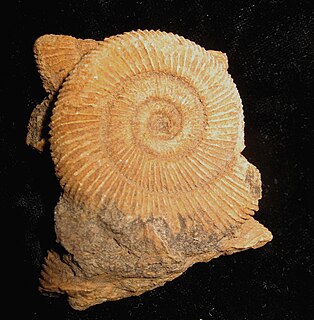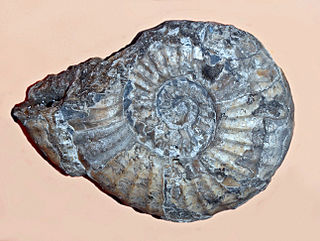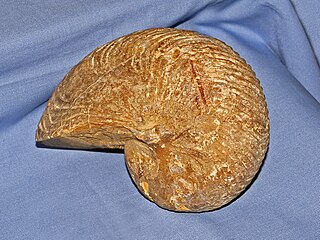Related Research Articles

Dactylioceras was a widespread genus of ammonites from the Lower Jurassic period, approximately 180 million years ago (mya).

A whorl is a single, complete 360° revolution or turn in the spiral growth of a mollusc shell. A spiral configuration of the shell is found in numerous gastropods, but it is also found in shelled cephalopods including Nautilus, Spirula and the large extinct subclass of cephalopods known as the ammonites.

Globigerina is a genus of planktonic Foraminifera, in the order of Rotaliida. It has populated the world's oceans since the Middle Jurassic.
Aegoceras (Beaniceras) is small, coarsely ribbed subgenus ammonite from the Lower Jurassic with coarsely ribbed rounded whorls. The shell is evolute, early whorls a barrel-shaped cadicone, later become serpenticonic.

Lytoceratina is a suborder of Jurassic and Cretaceous ammonites that produced loosely coiled, evolute and gyroconic shells in which the sutural element are said to have complex moss-like endings.

Ammonitina comprises a diverse suborder of ammonite cephalopods that lived during the Jurassic and Cretaceous periods of the Mesozoic Era. They are excellent index fossils, and it is often possible to link the rock layer in which they are found to specific geological time periods.
Euaptetoceras is an evolute hildoceratoid ammonite from the lower Middle Jurassic, included in the family Hammatoceratidae and the subfamility Hammatoceratinae. The genus may be a junior synonym for Eudmetoceras of Buckman, 1920.
Duashnoceras is an extinct ammonoid cephalopod genus included in the Stephanoceratidae that lived during the Bathonian stage of the Middle Jurassic.

Psiloceratoidea is a superfamily of Early Jurassic ammonoid cephalopods proposed by Hyatt in 1867, assigned to the order Ammonitida. They were very successful during Hettangian and Sinemurian. Last of them, family Cymbitidae and genera Hypoxynoticeras and Radstockiceras survived into Early Pliensbachian.

The Cymatoceratidae is a family of Mesozoic and early Cenozoic nautiloid cephalopods and the most abundant of this kind in the Cretaceous. They are characterized by ribbed, generally involute shells of varied form - coiled such that the outer whorl envelops the previous, as with Nautilus, and sutures that are variably sinuous.
Otoidtidae: stephanoceratoid ammonitina from the early Middle Jurassic that begin as cadicones but become more planualte with age; derived from the Hammitoceratidae (Hildoceratoidea), probably through Erycites by way of Abbasites.
Subcollina is a genus of evolute to serpenticonic stephanoceratacean ammonites from the Middle Jurassic (Baj) of Mexico, placed in the family Spiroceratidae.

Macrocephalites is a genus of the stephanoceratoid ammonite family Macrocephalitidae, diagnostic of the Callovian stage of the Middle Jurassic. Three subgenera, Dolikephalites, Kamptokephalites, and Pleurocephalites are recognized in addition to Macrocephalites itself, with Indocephalites tentatively included as the fourth.
Pachyceratidae is a family of Perisphinctoidean ammonites from the upper Middle - and lower Upper Jurassic. Genera within the Pachyceratidae have shells that are in general moderately involte but with most of the inner whorls exposed; whorl sections subquadrate to subtrapezoidal, with rounded venter. Ribbing is strong, in some sharp. Primary ribs typically branch above mid flanks into twos, threes, and even fours.
Hecticoceras is an ammonite genus belonging to the haploceratoid family Oppeliidae, that lived during the Middle and Late Jurassic, from the Callovian. Hecticoceras may be seen as a series of some nine subgenera, beginning with the lower Callovian H. (Hecticoceras) and H. (Hecticoceratoides) and ending with the lower Oxfordian H. (Pseudobrightia) and H. (Eochetoceras). Hecticocerassensu lato and Prohecticoceras from the underlying Bathonian form the oppeliid subfamily, Hecticoceratinae.

Lytoceratidae is a taxonomic family of ammonoid cephalopods belonging to the suborder Lytoceratina, characterized by very evolute shells that generally enlarge rapidly, having whorls in contact but mostly overlapping very sightly, or not at all.
Pleuroacanthites is one of two genera included in the Early Jurassic Pleuroacanthitidae and sole representative of the subfamily Pleuroacanthitinae. The shell of Pleuroacanthites is very evolute, with numerous whorls subcircular in section becoming incipiently keeled in the adult. Early whorls have parabolic nodes, later whorls are covered with oblique line which form a long ventral sinus. Sutures have lytoceratid (moss-like) lobes but more or less phylloid saddle endings.

Harpoceras is an extinct genus of cephalopod belonging to the family Hildoceratidae. These cephalopods existed in the Jurassic period, during Toarcian age from Falciferum zone to Commune subzone of Bifrons zone. They were fast-moving nektonic carnivores.
Ochetoceras is a genus of ammonites, belonging to the Oppeliidae, that lived during the Late Jurassic from the early Oxfordian to the early Tithonian, and type for the subfamily Ochetoceratinae.
Timidonella is a genus of large middle Jurassic forams, with microspheric tests up to 8 millimetres (0.31 in) in diameter. Smaller megalospheric tests may be fan-shaped or kidney-shaped to discoidal with breadths to slightly over 2 mm and a constant thickness equal to that of the proloculus. Chambers are numerous. The wall, microgranular calcareous, agglutinated.